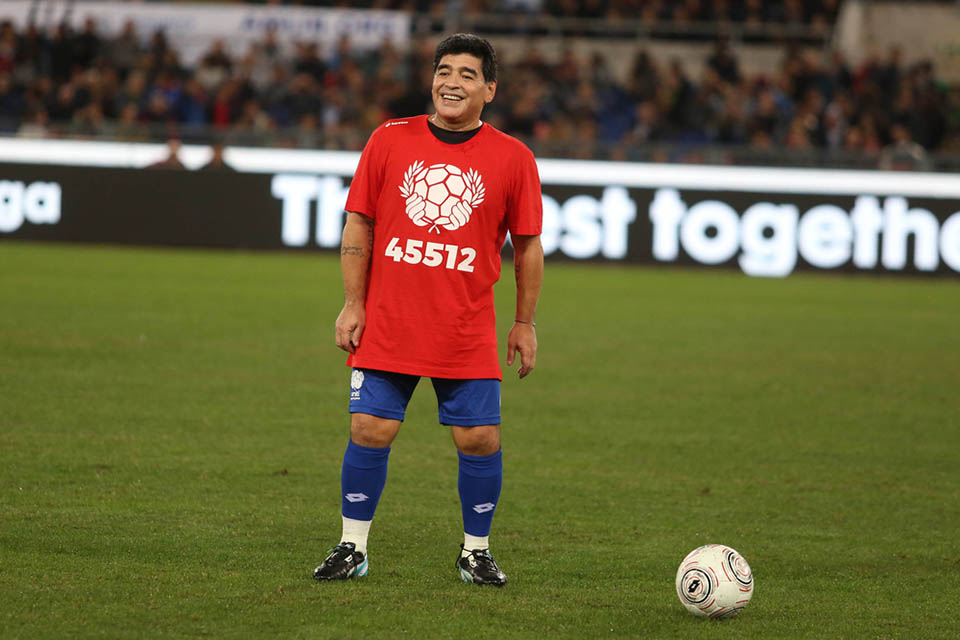A Tribute To Diego Maradona – A Symbol And A Legend That Will Never Be Forgotten

Maradona is one of the most famous athletes for people in our days. Born in Argentina in 1960 in extreme poverty, he grew up to become a professional football player and is regarded by many as the greatest football player of all time. He was extremely talented as a young boy and that’s why he was given the nickname ”El Pibe de Oro” meaning ‘The Golden Boy.” His nickname would accompany him throughout his whole career.
- Playing style
Diego was short (5ft 5 in). His low center of gravity combined with a very compact body frame gave him good balance, which greatly helped him dribbling past opponents without falling down from tackles. He possessed excellent acceleration and he could easily change direction on the field. He was also technically gifted, could keep possession in very tight spaces which made it hard for the opponents to take the ball from him. He was also known as a set-pieces specialist, scoring many goals from free-kicks and penalty kicks. The left-footed player who rarely used his right foot had an amazing way to keep the vision of the whole field. His presence on the field greatly improved the whole team’s performance. The combination of his special characteristics provided him with notable leadership skills that made his co-players show trust in his ”suggestions” during the game. - Early years and Club career
He started his career in ”Argentinos Juniors” and then ”Boca Juniors” the team he supported since his early childhood before moving to play in Europe for FC Barcelona. After a problematic period in Barcelona, he moved to the Italian club Napoli where he enjoyed the best and most successful years of his career. The year before he joined them, the team of Napoli had marginally avoided relegation. The appearance of Maradonna slowly transformed the team into a powerhouse in Italian football and led them to the most successful period in their history winning two Serie A championships and one European UEFA Cup. - National team
During his career, he participated in four World Cups. His first World Cup in 1982 had small success and ended as he received a red card for hitting an opponent.
The greatest achievement of his career though came with the Argentinian National Team in the 1986 World Cup held in Mexico where a string of legendary performances led Argentina to win the trophy. In the quarter-finals game against England, he scored an infamous goal with his hand which he called ”The hand of God.” Later in the match, after he received the ball in the middle of the pitch, he made an outstanding run dribbling past six English players including England’s goalkeeper, before scoring the goal that is widely considered as perhaps the best goal in World Cup history.
In the 1990 World Cup held in Italy, after winning against the host nation of Italy in the semi-finals, Argentina lost in a repeat final as of 1986 against Germany. The image of Diego Maradonna crying after the final went on to become the most iconic in his career.
The last World Cup where he appeared was in the 1994 World Cup held in the United States. He produced two excellent performances in the first two games against Greece (where he scored his last World Cup goal ever) and Nigeria. Right after the game against Nigeria, they called him for a doping test where he was found positive for using ephedrine. He was immediately banned from the remainder of the World Cup. Argentina’s performances were never the same after his omission. His legendary defensive midfielder and teammate Fernando Redondo famously said for the games that followed his omission ”I was instinctively trying to find him on the pitch and pass him the ball but I couldn’t find him anywhere.” - The years after his career
By the later part of the ’80s, Maradona had developed a full-grown cocaine addiction that eventually led to his downfall. After struggling with his addiction for almost two decades, in the middle of the ’00s, he came clean and coached the Argentinian National Team for the 2010 World Cup hosted by South Africa with small success. His death from heart failure on November 25th, 2020 shocked the football world., especially in Argentina, and Napoli where he was mourned for weeks. Diego Maradona captivated the hearts of thousands of people because he remained to be spontaneous and he never lied about his financial descent. Maradona was not the type of athlete who had a professional approach to the sport but he played in a passionate way making football fans go crazy about him.
Bring the best of the CEOWORLD magazine's global journalism to audiences in the United States and around the world. - Add CEOWORLD magazine to your Google News feed.
Follow CEOWORLD magazine headlines on: Google News, LinkedIn, Twitter, and Facebook.
Copyright 2025 The CEOWORLD magazine. All rights reserved. This material (and any extract from it) must not be copied, redistributed or placed on any website, without CEOWORLD magazine' prior written consent. For media queries, please contact: info@ceoworld.biz








